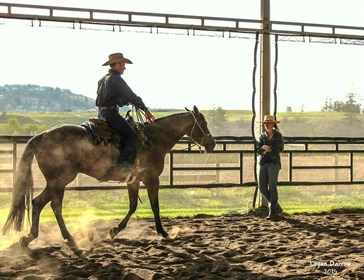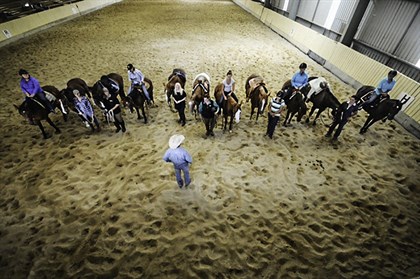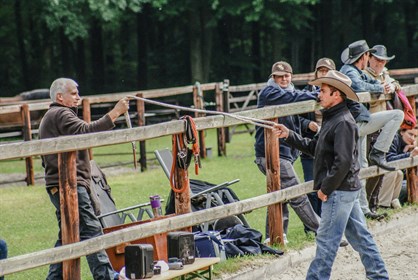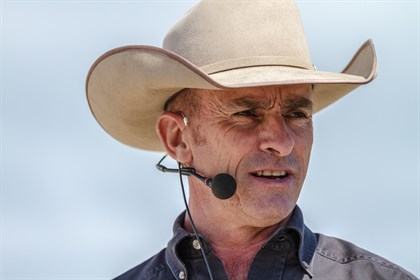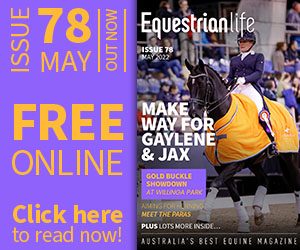
Warwick in action at a clinic in Canada.
© Logan Darrow
Warwick Schiller’s Performance Horse clinics are in big demand the world over because the Australian-born, California-based horseman shows that cultivating the inherent nature of horses is the secret to making them happy.
BY SUNDAY BATTERS
WARWICK SCHILLER: The first thing you have to understand is that you can’t keep your horse happy if you can’t get him happy in the first place. You have to figure out what makes horses happy. Do horses like carrots? Do horses like heavy rugs? There’s a lot of things that people think horses like, but you can’t truly say that until you understand the nature of horses. Horses are looking for that comfortable place. A happy horse is a horse that needs to be comfortable wherever he is, doing whatever he’s doing.
EQ Life: How do you get a horse to be comfortable?
WS: If you think about it, horses are looking for that place of comfort, the place to get left alone. And a lot of horses that I see when someone gets on them and goes in the arena, all they do for the whole 45 minutes is pull and kick and pull and kick. The only place that horse ever gets completely comfortable is when you ride over to the gate and leave the arena.
Warwick Schiller at a clinic in Australia.
© Robyn Schiller
EQ Life: Where did the term “destination addiction” come from?
WS: It actually came from a Facebook meme a couple of years ago. The meme said, “Beware of destination addiction!” Destination addiction is the idea that you will find happiness in the next house, in the next job, or with your next partner. Until you give up the idea that happiness is somewhere else, you will never be where you are.
EQ Life: How does it relate to horses?
WS: Most horses, no matter what they’re doing, are wishing they are somewhere else; they have that “destination addiction”. Most of the time it’s back to the barn, back to their stall, back to their paddock. It’s not because the horse just has to get back there, it’s because that’s the place where they feel the most comfortable; the place where they understand the rules, where they get left alone. A lot of my training has to do with dealing with that destination addiction. I have helped people all around the world of all different disciplines, and just teaching that one thing can completely change a horse in its discipline. That’s one of the big things I focus on: one of correct destination addiction, getting rid of that horse thinking, “I wish I could go back to the barn, I wish I could get out the gate”.
EQ Life: How do you go about correcting this?
WS: Have you ever heard the expression, “Make the wrong things hard and the right things easy? The trouble with making the wrong thing hard, you have to let them do the wrong thing first. And most of us are control freaks; you don’t want to let them do the wrong thing. And so, how do you make the wrong thing hard and the right thing easy? You first have to let them do the wrong thing! In the case of, say, you’re riding in the arena and they want to go to gate, I let them go to the gate. I let them run out to the gate, and when they get there they do more work than what they were currently doing!
They will drag you over to the gate (they won’t drag me because I’m not pulling), and want to stop there. All I do is walk small circles there, trot small circles, whatever it is that horse is capable of doing, and I’ll just stay there trotting small circles or walking small circles, whichever, and after a while they’ll start to go, “Oh, this is not as much fun as I thought it was” and they’ll start to drift away from that gate. They might go another 10 metres, and then they’ll go back and they’ll do it again, and they’ll do it again and they’ll do it again.
And every time they want to go back there, I allow them to go back there, and when they get there, there’s no fun! After a while they get to think, “Why do I want to go over there, that’s no fun!” I do the same thing with other horses in the arena. If my horse wants to drift to another horse, instead of saying you can’t go over there, I let him go over there. When they get there I just trot in circles round that other horse.
No horse actually wants to rear up, for instance. I’ve never seen a horse that wanted to rear up. Every horse that has come to me to have a rearing problem fixed has wanted to do something other than what the rider wanted to do, and instead of the rider saying, “Tell me all about it. What is it you want to do?” they say, “You can’t do that” and that’s when you get the rear. Does that make sense?
Warwick getting spectators involved in his clinics.
© Robyn Schiller
EQ Life: Yes, that makes sense. Do you have challenges in explaining this to people?
WS: Not usually, especially if it’s at a clinic and they get to see it happen. The first thing I usually take care of under saddle at clinics is allowing those horses to go wherever they want to go to. The hardest part for most people is just being able to turn loose and say, “Okay I trust you. Where do you want to go?”
The whole thing is supposed to be about happy horses. I’ve trained horses almost exclusively in arenas for the last 25 years and I’ve never had one not want to go in the arena. It’s not because we don’t do any work in there -- but I’m always making sure to take care of where they want to be. And the other thing is, there’s got to be just as much rest in the arena as there is work in the arena. A lot of times someone’s on their horse and they’re riding around in contact and they’ve got a lot of leg, a lot of contact, a lot of leg, a lot of contact, and then they finish their ride out of the arena. And that’s the only time they loosen that contact. So the horse thinks, “I understand what you’re trying to tell me; you’re trying to tell me that the arena’s no fun. The whole time we’re in there there’s never going to be any fun time. You’re trying to teach me to want to go out the gate. I can do that.” You know what I mean?
Most people say, “My horse doesn’t like the arena but he sure likes trail riding out in the natural environment”. I say to those people: “I want you for the next month, instead of going in the arena first, go out on the trail first, and do upward and downward transitions, leg-yields, lots of half-halts, lots of contact, lots of lateral movements, consistently for 45 minutes. And when you get back from your trail ride take him in the arena and ride him around on a buckle for half an hour. Do that every day for a month and then tell me what you horse likes. Does he like the trail or does he like the arena? Does he like the artificial surfaces or does he like the natural environment and cockies, galahs and kangaroos? He will like the arena and not like the trail.
It’s very easy for us to come up with these fantasies about what our horses do and don’t like. Really, your horse is looking for the place of most comfort, the place where they are mentally quite happy, and to me, I want to get those to wherever they are to be mentally happy. They could be walking, trotting, cantering, going left circle, right circle, doing flying-leap changes, just doing a reining spin, whatever. Wherever they are, that’s got to be the place where they’re quite happy to be and not wishing to be doing something else. If you think about a horse dropping its shoulder or running out through its shoulder, those sorts of things, all that horse is doing is trying to get to somewhere else other than where they are.
Warwick in action.
© Robyn Schiller
EQ Life: Do you believe if a horse drops a shoulder that by getting them comfortable we can actually get them equal on both shoulders?
WS: Oh yes. The next time you see someone riding a 20-metre circle and a horse drops its shoulder a bit, notice which side of the circle it dropped its shoulder on. I guarantee you it will drop its shoulder on the side of the circle away from the gate. And the side of the circle that the gate’s on? When it gets on that side, it’s nearly going to run its shoulder out.
In a lot of those circles the horse is leaning towards home; the gate home, the horse float, the other horses, whatever it might be. And so to me, taking care of what I call this destination addiction thing takes care of so many things. And you’re not wearing out all your aids -- your inside leg, your outside rein -- trying to stop your horse from going somewhere because he’s quite happy to be where he is. And there’s the word again, “happy”. What we’re talking about here is happy horses.
EQ Life: What about when you go to a competition and your horse feels uncomfortable at a particular end of an arena?
WS: That question comes up a lot, and that’s just taking an unprepared horse to a horse show. Really, you want to be able to stop that at home. Have you ever noticed that the scary end of the arena is always the end away from the gate? An example I use; I showed up for a clinic and a lady says, “Oh my goodness, I learnt something very, very valuable this morning”. I said, “What’s that?” She goes, “Well, my horse always spooks in that corner over there.” She points to the far end of the arena she normally rides. And she says, “See, there’s a blue plastic drum”… you know, one of those 44-gallon drums, 200-litre drum, whatever you call it. There was one of those there and it had a hole cut in it and it was sitting over there like a water meter or something, and she said, “My horse always spooks at that blue drum. I try to go down that long side of the arena, get to that blue drum and it just turns and runs off… bolts off. So anyway, this morning after we worked on that destination addiction stuff yesterday, I came in the arena and I turned my horse loose and said, ‘Where do want to go?’ and believe it or not, he went straight to the gate!”
So we worked him at the gate; he went away from the gate, he went back to the gate, worked him at the gate, he went away from the gate, back to the gate. She said, “I worked on the gate for about 45 minutes until he finally said, ‘You know what? I don’t like this end of the arena any more. We’ll go down the other end’.” And she said her horse walked down the fence on a loose rein where she normally he has to force him to go down there, and when she got to that corner she thought, “Oh God, he’s going to spook at the blue drum”. He went down there and looked at the blue drum and swerved about a metre sideways and kept walking. That was about it. She said, “I realised right then that that big supposed spook away from the drum was 97 per cent pull from the gate and three per cent push from the drum. I didn’t realise I didn’t have to fix the drum, it was just the catalyst. What I had to fix was the gate.”
EQ Life: You wouldn’t take an unprepared horse to a competition.
WS: Right, people try to fix things at a competition. I say, “How was it at home?” And they say he’s not very good at home either. I personally wouldn’t leave home with that horse because, as you would know, they’re never going to get better when they go to a competition. They are going to be the same or worse. No horse is going to go, “Hey! I’m at the competition, I’d better buckle down here. We’re going to win ourselves a ribbon!”
I like to be pretty prepared at home. Taking care of that stuff not only takes care of competition horses, it really takes care of trail riding, you know what I mean?
EQ Life: So, Warwick, how long does this process take?
WS: I’ll do it every single day for years. I mean, I don’t have to do it every day but I check on it every day. Like, do you ever pump up the tyres in your car? You might not have to pump them up every day, but when you need to pump them up, you need to pump them up. If it’s flat you’re not going to drive it. So you check on it.
Initially, you have to do quite a bit of it. For me, the more I do it initially, the less I have to do it later on. But every day I get on every horse, if they want to drift somewhere I turn them loose and say, “What is it that you’re that interested in?” And they get to wherever it is then we do some work there. What you’re doing is trying to get them to realise that the place they think is going to be really good is not really good. And they’ll think, “I’m sick of this stuff, can I do something else?” and they’ll drift away. When they drift away, I’ll turn them loose and just leave them on the buckle. If they go back, they’ll do it again and they get to realise, “If I go over there I have to work, and have to do constant work until I leave there, so I probably don’t want to go there”. Which is different to the work I do when I get to work in the rest of the arena. You ask, and when you get what you want you will release. But if we get to the gate and I ask for something, I don’t release at all; there is no release. They just have to keep working, working, working, until they decide to go somewhere else. The problem is not falling-in with the shoulder or running-out with the shoulder, the problem is that horse wishing it could go to the gate.
READ THE LATEST NEWS ARTICLES HERE
https://www.equestrianlife.com.au/articles/Dont-Worry-Be-Happy
